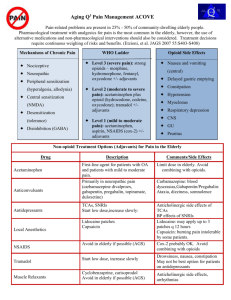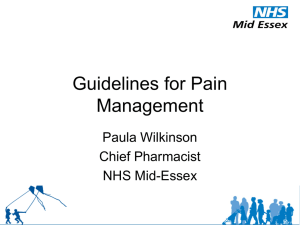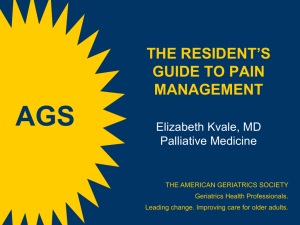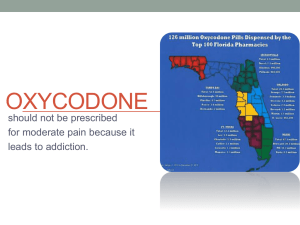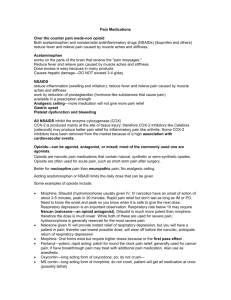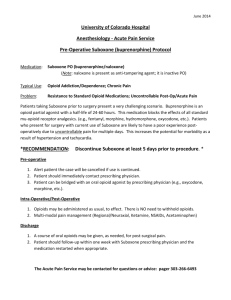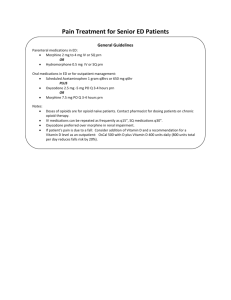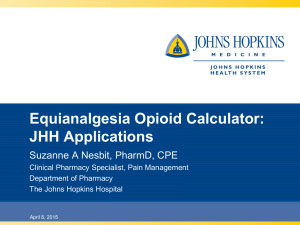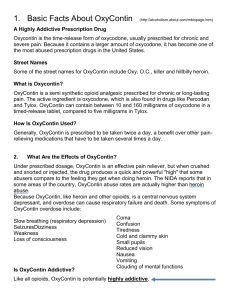הודעה על החמרה ( מידע בטיחות) בעלון לצרכן
advertisement
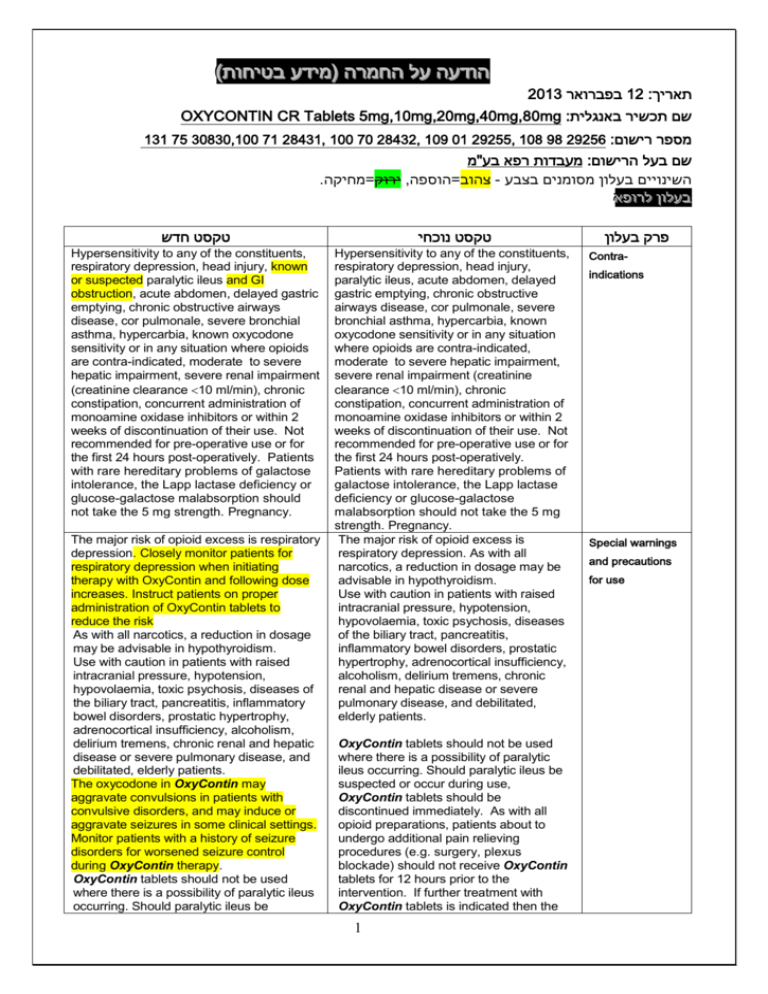
)בטיחות )מידע בטיחות החמרה ((מידע על החמרה הודעה על הודעה 2013 בפברואר12 :תאריך OXYCONTIN CR Tablets 5mg,10mg,20mg,40mg,80mg :שם תכשיר באנגלית 131 75 30830,100 71 28431, 100 70 28432, 109 01 29255, 108 98 29256 :מספר רישום מעבדות רפא בע"מ:שם בעל הרישום . ירוק=מחיקה, צהוב=הוספה- השינויים בעלון מסומנים בצבע רופא בעלון ללרופא בעלון טקסט חדש טקסט נוכחי Hypersensitivity to any of the constituents, respiratory depression, head injury, known or suspected paralytic ileus and GI obstruction, acute abdomen, delayed gastric emptying, chronic obstructive airways disease, cor pulmonale, severe bronchial asthma, hypercarbia, known oxycodone sensitivity or in any situation where opioids are contra-indicated, moderate to severe hepatic impairment, severe renal impairment (creatinine clearance 10 ml/min), chronic constipation, concurrent administration of monoamine oxidase inhibitors or within 2 weeks of discontinuation of their use. Not recommended for pre-operative use or for the first 24 hours post-operatively. Patients with rare hereditary problems of galactose intolerance, the Lapp lactase deficiency or glucose-galactose malabsorption should not take the 5 mg strength. Pregnancy. Hypersensitivity to any of the constituents, respiratory depression, head injury, paralytic ileus, acute abdomen, delayed gastric emptying, chronic obstructive airways disease, cor pulmonale, severe bronchial asthma, hypercarbia, known oxycodone sensitivity or in any situation where opioids are contra-indicated, moderate to severe hepatic impairment, severe renal impairment (creatinine clearance 10 ml/min), chronic constipation, concurrent administration of monoamine oxidase inhibitors or within 2 weeks of discontinuation of their use. Not recommended for pre-operative use or for the first 24 hours post-operatively. Patients with rare hereditary problems of galactose intolerance, the Lapp lactase deficiency or glucose-galactose malabsorption should not take the 5 mg strength. Pregnancy. The major risk of opioid excess is respiratory depression. As with all narcotics, a reduction in dosage may be advisable in hypothyroidism. Use with caution in patients with raised intracranial pressure, hypotension, hypovolaemia, toxic psychosis, diseases of the biliary tract, pancreatitis, inflammatory bowel disorders, prostatic hypertrophy, adrenocortical insufficiency, alcoholism, delirium tremens, chronic renal and hepatic disease or severe pulmonary disease, and debilitated, elderly patients. The major risk of opioid excess is respiratory depression. Closely monitor patients for respiratory depression when initiating therapy with OxyContin and following dose increases. Instruct patients on proper administration of OxyContin tablets to reduce the risk As with all narcotics, a reduction in dosage may be advisable in hypothyroidism. Use with caution in patients with raised intracranial pressure, hypotension, hypovolaemia, toxic psychosis, diseases of the biliary tract, pancreatitis, inflammatory bowel disorders, prostatic hypertrophy, adrenocortical insufficiency, alcoholism, delirium tremens, chronic renal and hepatic disease or severe pulmonary disease, and debilitated, elderly patients. The oxycodone in OxyContin may aggravate convulsions in patients with convulsive disorders, and may induce or aggravate seizures in some clinical settings. Monitor patients with a history of seizure disorders for worsened seizure control during OxyContin therapy. OxyContin tablets should not be used where there is a possibility of paralytic ileus occurring. Should paralytic ileus be OxyContin tablets should not be used where there is a possibility of paralytic ileus occurring. Should paralytic ileus be suspected or occur during use, OxyContin tablets should be discontinued immediately. As with all opioid preparations, patients about to undergo additional pain relieving procedures (e.g. surgery, plexus blockade) should not receive OxyContin tablets for 12 hours prior to the intervention. If further treatment with OxyContin tablets is indicated then the 1 פרק בעלון Contraindications Special warnings and precautions for use suspected or occur during use, OxyContin tablets should be discontinued immediately. As with all opioid preparations, patients about to undergo additional pain relieving procedures (e.g. surgery, plexus blockade) should not receive OxyContin tablets for 12 hours prior to the intervention. If further treatment with OxyContin tablets is indicated then the dosage should be adjusted to the new post-operative requirement. OxyContin 80 mg should not be used in patients not previously exposed to opioids. This tablet strength may cause fatal respiratory depression when administered to opioid naïve patients. As with all opioid preparations, OxyContin tablets should be used with caution following abdominal surgery as opioids are known to impair intestinal motility and should not be used until the physician is assured of normal bowel function. For appropriate patients who suffer with chronic non-malignant pain, opioids should be used as part of a comprehensive treatment programme involving other medications and treatment modalities. A crucial part of the assessment of a patient with chronic non-malignant pain is the patient’s addiction and substance abuse history. There is potential for development of psychological dependence (addiction) to opioid analgesics, including oxycodone. OxyContin tablets, like all opioids, should be avoided in patients with a history of, or present alcohol and drug abuse. If opioid treatment is considered appropriate for the patient, then the main aim of treatment is not to minimise the dose of opioid but rather to achieve a dose which provides adequate pain relief with a minimum of side effects. There must be frequent contact between physician and patient so that dosage adjustments can be made. It is strongly recommended that the physician defines treatment outcomes in accordance with pain management guidelines. The physician and patient can then agree to discontinue treatment if these objectives are not met. Hyperalgesia that will not respond to a further dose increase of oxycodone may very rarely occur in particular in high doses. An oxycodone dose reduction or change in opioid may be required. OxyContin has an abuse profile similar to other strong opioids. Oxycodone may be sought and abused by people with latent or manifest addiction disorders. As with other opioids, infants who are born to dependent mothers may exhibit withdrawal symptoms and may have respiratory depression at birth. dosage should be adjusted to the new post-operative requirement. OxyContin 80 mg should not be used in patients not previously exposed to opioids. This tablet strength may cause fatal respiratory depression when administered to opioid naïve patients. As with all opioid preparations, OxyContin tablets should be used with caution following abdominal surgery as opioids are known to impair intestinal motility and should not be used until the physician is assured of normal bowel function. For appropriate patients who suffer with chronic non-malignant pain, opioids should be used as part of a comprehensive treatment programme involving other medications and treatment modalities. A crucial part of the assessment of a patient with chronic nonmalignant pain is the patient’s addiction and substance abuse history. There is potential for development of psychological dependence (addiction) to opioid analgesics, including oxycodone. OxyContin tablets, like all opioids, should be avoided in patients with a history of, or present alcohol and drug abuse. If opioid treatment is considered appropriate for the patient, then the main aim of treatment is not to minimise the dose of opioid but rather to achieve a dose which provides adequate pain relief with a minimum of side effects. There must be frequent contact between physician and patient so that dosage adjustments can be made. It is strongly recommended that the physician defines treatment outcomes in accordance with pain management guidelines. The physician and patient can then agree to discontinue treatment if these objectives are not met. Hyperalgesia that will not respond to a further dose increase of oxycodone may very rarely occur in particular in high doses. An oxycodone dose reduction or change in opioid may be required. OxyContin has an abuse profile similar to other strong opioids. Oxycodone may be sought and abused by people with latent or manifest addiction disorders. As with other opioids, infants who are born to dependent mothers may exhibit 2 OxyContin tablets must be swallowed whole, and not broken, chewed or crushed. The administration of broken, chewed or crushed OxyContin tablets leads to a rapid release and absorption of a potentially fatal dose of oxycodone (see Section 4.9). OxyContin 10, 20, 40, 80: There have been post-marketing reports of difficulty in swallowing OxyContin tablets. These reports included choking, gagging, regurgitation and tablets stuck in the throat. Instruct patients not to pre-soak, lick or otherwise wet OxyContin tablets prior to placing in the mouth, and to take one tablet at a time with enough water to ensure complete swallowing immediately after placing in the mouth. There have been rare post-marketing reports of cases of intestinal obstruction, and exacerbation of diverticulitis, some of which have required medical intervention to remove the tablet. Patients with underlying GI disorders such as esophageal cancer or colon cancer with a small gastrointestinal lumen are at greater risk of developing these complications. Use caution when prescribing OxyContin for patients who have difficulty swallowing or have underlying GI disorders that may predispose them to obstruction. Consider use of an alternative analgesic in patients who have difficulty swallowing and patients at risk for underlying GI disorders resulting in a small gastrointestinal lumen. Concomitant use of alcohol and OxyContin may increase the undesirable effects of OxyContin; concomitant use should be avoided. Abuse of the tablets by parenteral administration can be expected to result in other serious adverse events, such as local tissue necrosis, infection, pulmonary granulomas, increased risk of endocarditis, and valvular heart injury, which may be fatal. OxyContin, like other opioids, potentiates the effects of tranquillisers, anaesthetics, hypnotics, anti-depressants, sedatives, phenothiazines, neuroleptic drugs, other opioids, muscle relaxants and antihypertensives. Monoamine oxidase inhibitors are known to interact with narcotic analgesics, producing CNS excitation or depression with hypertensive or hypotensive crisis. Concurrent use of OxyContin and other central nervous system (CNS) depressants including sedatives or hypnotics, general anesthetics, phenothiazines, tranquilizers, withdrawal symptoms and may have respiratory depression at birth. OxyContin tablets must be swallowed whole, and not broken, chewed or crushed. The administration of broken, chewed or crushed OxyContin tablets leads to a rapid release and absorption of a potentially fatal dose of oxycodone (see Section 4.9). OxyContin 10, 20, 40, 80: There have been post-marketing reports of difficulty in swallowing OxyContin tablets. These reports included choking, gagging, regurgitation and tablets stuck in the throat. Instruct patients not to pre-soak, lick or otherwise wet OxyContin tablets prior to placing in the mouth, and to take one tablet at a time with enough water to ensure complete swallowing immediately after placing in the mouth. There have been rare post-marketing reports of cases of intestinal obstruction, and exacerbation of diverticulitis, some of which have required medical intervention to remove the tablet. Patients with underlying GI disorders such as esophageal cancer or colon cancer with a small gastrointestinal lumen are at greater risk of developing these complications. Use caution when prescribing OxyContin for patients who have difficulty swallowing or have underlying GI disorders that may predispose them to obstruction. Concomitant use of alcohol and OxyContin may increase the undesirable effects of OxyContin; concomitant use should be avoided. Abuse of the tablets by parenteral administration can be expected to result in other serious adverse events, such as local tissue necrosis, infection, pulmonary granulomas, increased risk of endocarditis, and valvular heart injury, which may be fatal. OxyContin, like other opioids, potentiates the effects of tranquillisers, anaesthetics, hypnotics, anti-depressants, sedatives, phenothiazines, neuroleptic drugs, other opioids. Monoamine oxidase inhibitors are known to interact with narcotic analgesics, producing CNS excitation or depression with hypertensive or hypotensive crisis. Alcohol may enhance the pharmacodynamic effects of OxyContin; concomitant use should be avoided. 3 Interaction with other medicinal products and other forms of interaction and alcohol can increase the risk of respiratory depression, hypotension, profound sedation or coma. Monitor patients receiving CNS depressants and OxyContin for signs of respiratory depression and hypotension. When such combined therapy is contemplated, reduce the initial dose of OxyContin and consider using a lower dose of the concomitant CNS depressant. Alcohol may enhance the pharmacodynamic effects of OxyContin; concomitant use should be avoided. Mixed Agonist/Antagonist Opioid Analgesics (i.e., pentazocine, nalbuphine, and butorphanol) - should generally not be administered to a patient who has received or is receiving a course of therapy with a pure opioid agonist analgesic such as OxyContin. In this situation, mixed agonist/antagonist analgesics may reduce the analgesic effect of oxycodone and may precipitate withdrawal symptoms in these patients. Diuretics - opioids can reduce the efficacy of diuretics by inducing the release of antidiuretic hormone. opioids may also lead to acute retention of urine by causing spasm of the sphincter of the bladder, particularly in men with enlarged prostates. Anticholinergics or other medications with anticholinergic activity - when used concurrently with opioid analgesics may result in increased risk of urinary retention and/or severe constipation, which may lead to paralytic ileus. Monitor patients for signs of urinary retention or reduced gastric motility when OxyContin is used concurrently with anticholinergic drugs. Oxycodone is metabolized in part via the CYP2D6 and CYP3A4 pathways. The activities of these metabolic pathways may be inhibited or induced by various coadministered drugs or dietary elements. Oxycodone doses may need to be adjusted accordingly. Cimetidine and CYP3A4 inhibitors, such as macrolide antibiotics (e.g., clarithromycin, erythromycin), azole-antifungal agents (e.g., ketoconazole, voriconazole), and protease inhibitors (e.g., ritonavir), grapefruit juice may cause decreased clearance of oxycodone which could lead to an increase in oxycodone plasma concentrations. CYP3A4 inducers, such as rifampin, carbamazepine, and phenytoin St. John's wort, may induce the metabolism of oxycodone and cause increased clearance of the drug, resulting in a decrease in oxycodone plasma concentrations. Drugs that inhibit CYP2D6 activity, such as paroxetine and quinidine, may cause decreased clearance of oxycodone which Oxycodone is metabolized in part via the CYP2D6 and CYP3A4 pathways. The activities of these metabolic pathways may be inhibited or induced by various co-administered drugs or dietary elements. Oxycodone doses may need to be adjusted accordingly. Cimetidine and CYP3A4 inhibitors, such as macrolide antibiotics (e.g., clarithromycin, erythromycin), azoleantifungal agents (e.g., ketoconazole, voriconazole), protease inhibitors (e.g., ritonavir), and grapefruit juice may cause decreased clearance of oxycodone which could lead to an increase in oxycodone plasma concentrations. CYP3A4 inducers, such as rifampin, carbamazepine, phenytoin and St. John's wort, may induce the metabolism of oxycodone and cause increased clearance of the drug, resulting in a decrease in oxycodone plasma concentrations. Drugs that inhibit CYP2D6 activity, such as paroxetine and quinidine, may cause decreased clearance of oxycodone which could lead to an increase in oxycodone plasma concentrations. 4 could lead to an increase in oxycodone plasma concentrations. Adverse drug reactions are typical of full opioid agonists. Tolerance and dependence may occur (see Tolerance and Dependence, below). Constipation may be prevented with an appropriate laxative. If nausea and vomiting are troublesome, oxycodone may be combined with an antiemetic. Common (incidence of ≥ 1%) and uncommon (incidence of ≤ 1%) adverse drug reactions are listed in the table below: Body System Immune system disorders Common Uncommon Anaphylactic reaction Anaphylactoid reaction Hypersensitivity Metabolism and nutritional disorders Psychiatric disorders Decreased appetite Anorexia Anxiety Confusional state Insomnia Nervousness Thinking abnormal Abnormal dreams Depression Nervous system disorders Affect lability Agitation Drug dependence Euphoric mood Hallucination Dizziness Sedation Somnolence Tremor Hypertonia Hypoaesthesia Hypotonia Paresthesia Speech disorder Convulsions Muscle contractions involuntary Dysgeusia Syncope Hyperalgesia Eye disorders Miosis Vision impairment Ear and labyrinth disorders Vertigo Tinnitus Supraventricular tachycardia Common Bronchospasm Dyspnoea Cough decreased Uncommon Anaphylactic reaction Anaphylactoid reaction Hypersensitivity Metabolism and nutritional disorders Decreased appetite Dehydration Psychiatric disorders Anxiety Affect lability Confusional state Insomnia Nervousness Thinking abnormal Abnormal dreams Depression Agitation Headache Amnesia Dizziness Sedation Somnolence Tremor Hypertonia Hypoaesthesia Hypotonia Paresthesia Speech disorder Convulsions Muscle contractions involuntary Dysgeusia Syncope Hyperalgesia Nervous system disorders Drug dependence Euphoric mood Hallucination Libido decreased Disorientation Mood altered Restlessness Dysphoria Eye disorders Miosis Vision impairment Ear and labyrinth disorders Vertigo Cardiac disorders Supraventricular tachycardia Vascular disorders Hypotension Hypotension Orthostatic hypotension Vasodilatation Facial flushing Respiratory, thoracic and mediastinal disorders Body System Immune system disorders Libido decreased Disorientation Mood altered Restlessness Dysphoria Amnesia Vascular disorders Common (incidence of ≥ 1%) and uncommon (incidence of ≤ 1%) adverse drug reactions are listed in the table below: Dehydration Headache Cardiac disorders Adverse drug reactions are typical of full opioid agonists. Tolerance and dependence may occur (see Tolerance and Dependence, below). Constipation may be prevented with an appropriate laxative. If nausea and vomiting are troublesome, oxycodone may be combined with an anti-emetic. Orthostatic hypotension Vasodilatation Facial flushing Respiratory depression Hiccups Respiratory, thoracic and mediastinal disorders Bronchospasm Dyspnoea Respiratory depression Hiccups Cough decreased Gastrointestinal disorders 5 Constipation Nausea Vomiting Dental caries Dysphagia Eructation Undesirable effects Gastrointestinal disorders Constipation Nausea Vomiting Dry mouth Dyspepsia Abdominal Pain Diarrhoea Hepato-biliary disorders Dental caries Dysphagia Eructation Flatulence Ileus Gastritis Hyperhidrosis Pruritus Rash Dry skin Exfoliative dermatitis Musculoskelet al and connective tissue disorders Muscular rigidity Renal and urinary disorders Urinary retention Flatulence Ileus Gastritis Biliary colic Cholestasis Hepatic enzyme increased Skin and subcutaneous tissue disorders Hyperhidrosis Pruritus Rash Dry skin Exfoliative dermatitis Musculoskeletal and connective tissue disorders Muscular rigidity Renal and urinary disorders Urinary retention Ureteral spasm Ureteral spasm Reproductive system and breast disorders General disorders and administration site conditions Hepato-biliary disorders Biliary colic Cholestasis Hepatic enzyme increased Skin and subcutaneous tissue disorders Dry mouth Dyspepsia Abdominal Pain Diarrhoea Amenorrhoea Erectile dysfunction Asthenic conditions Reproductive system and breast disorders General disorders and administration site conditions OxyContin 10, 20, 40, 80: The following have also been reported, potentially due to the swelling and hydrogelling property of the tablet: choking, gagging, regurgitation, tablets stuck in the throat and difficulty swallowing the tablet. Tolerance and Dependence: The patient may develop tolerance to the drug with chronic use and require progressively higher doses to maintain pain control. Prolonged use of OxyContin tablets may lead to physical dependence and a withdrawal syndrome may occur upon abrupt cessation of therapy. When a patient no longer requires therapy with oxycodone, it may be advisable to taper the dose gradually to prevent symptoms of withdrawal. The opioid abstinence or withdrawal syndrome is characterised by some or all of the following: restlessness, lacrimation, rhinorrhea, yawning, perspiration, chills, myalgia, mydriasis and palpitations. Other symptoms also may Asthenic conditions Drug tolerance Oedema Oedema peripheral Malaise Thirst Pyrexia Drug withdrawal syndrome Chills ST depression ( investigations) Drug tolerance Oedema Oedema peripheral Malaise Thirst Pyrexia Drug withdrawal syndrome Chills Lymphadenopathy Chest pain ST depression ( investigations) Lymphadenopathy Chest pain Amenorrhoea Erectile dysfunction OxyContin 10, 20, 40, 80: The following have also been reported, potentially due to the swelling and hydrogelling property of the tablet: choking, gagging, regurgitation, tablets stuck in the throat and difficulty swallowing the tablet. Tolerance and Dependence: The patient may develop tolerance to the drug with chronic use and require progressively higher doses to maintain pain control. Prolonged use of OxyContin tablets may lead to physical dependence and a withdrawal syndrome may occur upon abrupt cessation of therapy. When a patient no longer requires therapy with oxycodone, it may be advisable to taper the dose gradually to prevent symptoms of withdrawal. The opioid abstinence or withdrawal syndrome is characterised by some or all of the following: restlessness, lacrimation, rhinorrhea, yawning, perspiration, chills, myalgia, mydriasis and palpitations. Other symptoms also may develop, including: irritability, anxiety, backache, joint pain, weakness, abdominal cramps, insomnia, nausea, anorexia, vomiting, diarrhoea, or 6 develop, including: irritability, anxiety, backache, joint pain, weakness, abdominal cramps, insomnia, nausea, anorexia, vomiting, diarrhoea, or increased blood pressure, respiratory rate or heart rate. Postmarketing Experience: The following adverse reactions have been identified during post-approval use of controlled-release oxycodone: abuse, addiction, amenorrhea, cholestasis, death, dental caries, increased hepatic enzymes, hyperalgesia, hyponatremia, ileus, muscular hypertonia, overdose, palpitations (in the context of withdrawal), seizures, syndrome of inappropriate antidiuretic hormone secretion, and urticaria. Anaphylaxis has been reported with ingredients contained in OxyContin. Advise patients how to recognize such a reaction and when to seek medical attention. Signs of oxycodone toxicity and overdose are miosis, respiratory depression, hypotension and hallucinations. Circulatory failure and somnolence progressing to stupor or deepening coma, hypotonia, bradycardia, and death may occur in more severe cases. increased blood pressure, respiratory rate or heart rate. Signs of oxycodone toxicity and overdose are miosis, respiratory depression, hypotension and hallucinations. Circulatory failure and somnolence progressing to stupor or deepening coma, hypotonia, bradycardia, and death may occur in more severe cases. The effects of overdosage will be potentiated by the simultaneous ingestion of alcohol or other psychotropic drugs. Treatment of oxycodone overdosage: Primary attention should be given to the establishment of a patent airway and institution of assisted or controlled ventilation. In the case of massive overdosage, administer naloxone intravenously (0.4 to 2 mg for an adult and 0.01 mg/kg body weight for children), if the patient is in a coma or respiratory depression is present. Repeat the dose at 2 minute intervals if there is no response. If repeated doses are required then an infusion of 60% of the initial dose per hour is a useful starting point. A solution of 10 mg made up in 50 ml dextrose will produce 200 micrograms/ml for infusion using an IV pump (dose adjusted to the clinical response). Infusions are not a substitute for frequent review of the patient’s clinical state. Intramuscular naloxone is an alternative in the event IV access is not possible. As the duration of action of naloxone is relatively short, the patient must be carefully monitored until spontaneous respiration is reliably re-established. Naloxone is a competitive antagonist and large doses (4 mg) may be required in seriously poisoned patients. For less severe overdosage, administer naloxone 0.2 mg intravenously followed by The effects of overdosage will be potentiated by the simultaneous ingestion of alcohol or other psychotropic drugs. Treatment of oxycodone overdosage: Primary attention should be given to the establishment of a patent airway and institution of assisted or controlled ventilation. In the case of massive overdosage, administer naloxone intravenously (0.4 to 2 mg for an adult and 0.01 mg/kg body weight for children), if the patient is in a coma or respiratory depression is present. Repeat the dose at 2 minute intervals if there is no response. If repeated doses are required then an infusion of 60% of the initial dose per hour is a useful starting point. A solution of 10 mg made up in 50 ml dextrose will produce 200 micrograms/ml for infusion using an IV pump (dose adjusted to the clinical response). Infusions are not a substitute for frequent review of the patient’s clinical state. Intramuscular naloxone is an alternative in the event IV access is not possible. As the duration of action of naloxone is relatively short, the patient must be carefully monitored until spontaneous respiration is reliably reestablished. Naloxone is a competitive antagonist and large doses (4 mg) may be required in seriously poisoned patients. For less severe overdosage, administer 7 Overdose increments of 0.1 mg every 2 minutes if required. The patient should be observed for at least 6 hours after the last dose of naloxone. Naloxone should not be administered in the absence of clinically significant respiratory or circulatory depression secondary to oxycodone overdosage. Naloxone should be administered cautiously to persons who are known, or suspected, to be physically dependent on oxycodone. In such cases, an abrupt or complete reversal of opioid effects may precipitate pain and an acute withdrawal syndrome. Additional/other considerations: Consider activated charcoal (50 g for adults, 10 -15 g for children), if a substantial amount has been ingested within 1 hour, provided the airway can be protected. It may be reasonable to assume that late administration of activated charcoal may be beneficial for prolonged release preparations; however there is no evidence to support this. OxyContin tablets will continue to release and add to the oxycodone load for up to 12 hours after administration and management of oxycodone overdosage should be modified accordingly. Gastric contents may need to be emptied as this can be useful in removing unabsorbed drug, particularly when a prolonged release formulation has been taken. naloxone 0.2 mg intravenously followed by increments of 0.1 mg every 2 minutes if required. The patient should be observed for at least 6 hours after the last dose of naloxone. Naloxone should not be administered in the absence of clinically significant respiratory or circulatory depression secondary to oxycodone overdosage. Naloxone should be administered cautiously to persons who are known, or suspected, to be physically dependent on oxycodone. In such cases, an abrupt or complete reversal of opioid effects may precipitate pain and an acute withdrawal syndrome. Additional/other considerations: Consider activated charcoal (50 g for adults, 10 -15 g for children), if a substantial amount has been ingested within 1 hour, provided the airway can be protected. It may be reasonable to assume that late administration of activated charcoal may be beneficial for prolonged release preparations; however there is no evidence to support this. OxyContin tablets will continue to release and add to the oxycodone load for up to 12 hours after administration and management of oxycodone overdosage should be modified accordingly. Gastric contents may need to be emptied as this can be useful in removing unabsorbed drug, particularly when a prolonged release formulation has been taken. 8
